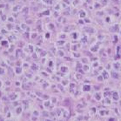Non-Hodgkin Lymphoma
General Information
Non-Hodgkin Lymphoma is a cancer of the lymphatic system (part of the immune system). The lymphatic system includes lymph vessels, lymph, lymph nodes, tonsils, thymus and the spleen. Lymphatic tissue is also found in the stomach, skin and small intestines. Lymphocytes consist of NK cells – Defends the host from tumors and virally infected cells, T cells – cell mediated immunity (response that does not involve antibodies) and B cells – humoral immunity (relating to antibodies). Non-Hodgkin lymphoma begins with an abnormal lymphocyte (usually a B cell); the cell divides and multiplies numerous times making more abnormal cells. These cells do not die as they should and are not protecting the body from infections or other diseases. As a result, the lymphatic cells begin to overcrowd, invade and destroy lymphoid tissues and eventually spread to other organs. A patient with Non-Hodgkin lymphoma can have many symptoms, some of which include swollen lymph nodes, weight loss, fever, night sweats and weakness. Non-Hodgkin’s Lymphoma is characterized in four stages Stage I – Lymphoma cells are in one lymph node group or one part of a tissue or organ, Stage II – Cells are found in at least two lymph node groups on the same side or in one part of an organ and the lymph nodes near that organ, Stage III – Lymphoma is in lymph nodes above and below the diaphragm and may also be found in one organ or area near the lymph nodes, Stage IV – Cancer has spread beyond the lymphatic system involving one or more major organ, may include bone marrow or skin. Staging the lymphoma helps the health-care provider select the appropriate treatment options; they can also better understand the prognosis of the disease. Treatment for Non-Hodgkin’s Lymphoma depends on the patients overall health, age, type, location, grade and stage of the disease. Treatment options include Chemotherapy, Radiation, Stem cell transplantation, Wait and see approach, Biotherapy, Radioimmunotherapy and Interferon therapy.
Epidemiology
Fifth most common cancer in the United States
Etiology
Abnormal growth of lymphocytes (usually a B cell)
Pathogenesis
Lymphocytes grow abnormal, divide and make copies of themselves; abnormal cells do not die when they should
Clinical
Most common sign is swelling in one or more lymph nodes
Histology
Large masses or small-scattered patches of cells that may show atypical nuclei and atypical mitoses. Large masses of tumor cells from the reticular dermis deep into the subcutaneous tissue
Bibliography
1. “Non-Hodgkin’s Lymphoma” (Online).August 2006. http://www.medicinenet.com/non-hodgkins_lymphomas/article.htm (visited: March 25, 2008) 2. “Non-Hodgkin’s Lymphoma” (Online). February 2008. http://www.cancer.gov/cancertopics/wyntk/non-hodgkin-lymphoma/page1 (visited: March 25, 2008) 3. “Non-Hodgkin’s Lymphoma” (Online). December 2007. http://www.oncologychannel.com/nonhodgkins/index.shtml (visited: March 25, 2008)


